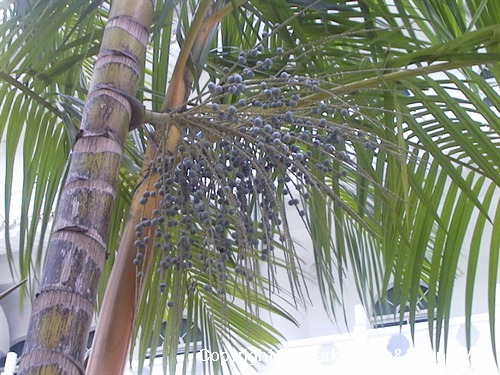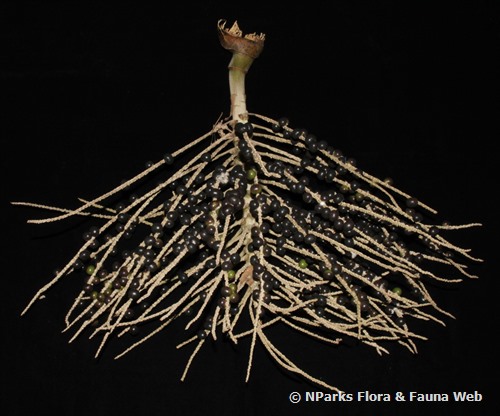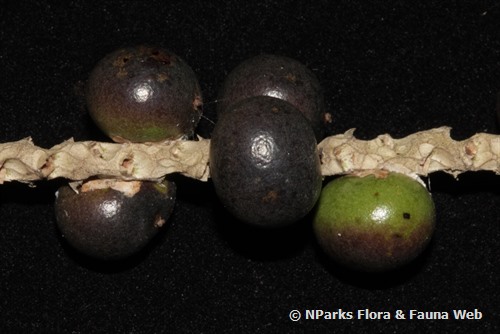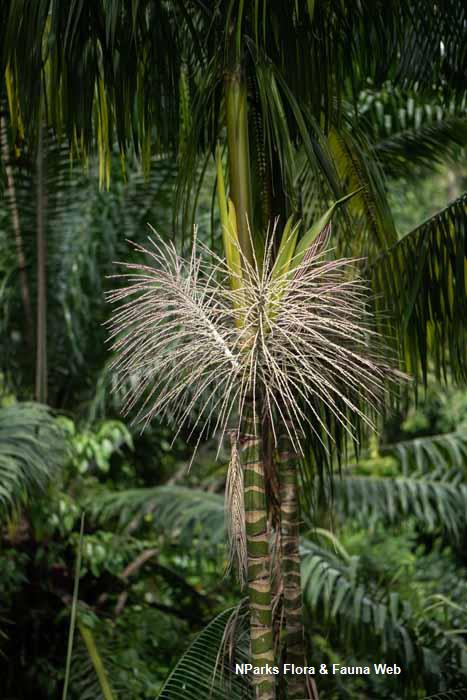
Back
Euterpe oleracea
| Family Name: | Arecaceae (Palmae) |
| Synonyms: | Euterpe badiocarpa, Euterpe cuatrecasana, Euterpe beardii, Catis martiana |
| Common Name: | Assai Palm, Cabbage Palm, Acai, Euterpe Palm, Multi-stemmed Assai Palm, 蔬食埃塔棕 |
Name
Classifications and Characteristics
| Plant Division | Angiosperms (Flowering Seed Plants) (Monocotyledon) |
|---|---|
| Plant Growth Form | Palm (Solitary Habit, Clustered Habit) |
| Mode of Nutrition | Autotrophic |
| Maximum Height | 30 m |
Biogeography
| Native Distribution | Brazil, Ecuador, Venezuela, Trinidad & French Guiana |
|---|
Description and Ethnobotany
| Growth Form | A tall, slender, moderately fast-growing, clumping (sometimes solitary) palm with numerous slender stems by which a few are dominant while others sucker around the base, topped with a graceful crown of finely cut, arching, feathery fronds. |
|---|---|
| Trunk | Trunk solitary or clumping, smooth, up to 15 cm in diameter, grey, marked with rings of old leaf scars. |
| Foliage | Fronds pinnate (feather-shaped), arching, ascending to spreading, about 2 to3 m long; leaflets 50 cm long, 4 cm wide. |
| Fruit | Fruits globose, about 1.5 cm in diameter, fibrous, ripening from green to purple-black, single-seeded. |
| Others - Plant Morphology | Flower: Inflorescences branched, about 1 m long, cream, arising below the leaves; female flowers about 2 to 3 times larger than male flowers. |
| Cultivation | Grows well in both full sun and partial shade but requires shelter when young. Needs a consistently warm and humid environment with constant amount of water. Thrives in rich, moist and well-drained soils. Propagate by division of side shoots or seeds, which germinate within 2 to 4 months. |
| Etymology | The genus epithet 'Euterpe' comes from a Greek mythological name for one of the nine goddesses of the liberal arts. The species epithet 'oleracea' means 'vegetable' in Latin, in reference to the heart of the stem, which is eaten as a vegetable. |
| Ethnobotanical Uses | Food (Fruit or Vegetable) (Herb or Spice) Others: Food: The fruit is highly valued by the eastern Amazonia for use in wine or as a juice, The juice is extracted from the small round fruit by soaking the seeds in water to soften the thin outer layer, then squeezed and strained to collect a thick purple liquid that has a unique flavor. The liquid is served chilled with sugar and tapioca flour. The juice can be processed into ice cream, liquor, mousses and sweets in general. Fruits can also be eaten raw. Medicinal: Fruits are packed full of antioxidants, amino acids and essential fatty acids. Studies show that the fruit has up to 33 times more antioxidant content as red wine grapes. It helps by providing energy, vitality, and increased stamina. Medically, extracted pulp has shown to have anti-inflammatory activity, immune system stimulation and in some studies, anti-cancer/tumor activity. Others: Leaves can be wooven into hats, mats, baskets, brooms and for making roof thatch. Trunk woods are resistant to pests, thus excellent for building construction. Stems may be processed to yield minerals. Seeds may be ground for livestock food or as a component of organic soil for plants. |
Plant Care and Propagation
| Light Preference | Semi-Shade, Full Sun |
|---|---|
| Water Preference | Moderate Water |
| Plant Growth Rate | Moderate |
Foliar
| Mature Foliage Colour(s) | Green |
|---|---|
| Foliar Shape(s) | Palm Fronds (Pinnate / Feather) |
| Leaf Area Index (LAI) for Green Plot Ratio | 4.0 (Palm - Cluster) |
Non - Foliar and Storage
| Trunk Type (Palm) | Aboveground, Clustering Habit |
|---|
Floral (Angiosperm)
| Flower Colour(s) | Cream / Off-White |
|---|
Fruit, Seed and Spore
| Mature Fruit Colour(s) | Black, Purple |
|---|
Image Repository
Others
| Master ID | 1335 |
|---|---|
| Species ID | 2628 |
| Flora Disclaimer | The information in this website has been compiled from reliable sources, such as reference works on medicinal plants. It is not a substitute for medical advice or treatment and NParks does not purport to provide any medical advice. Readers should always consult his/her physician before using or consuming a plant for medicinal purposes. |






